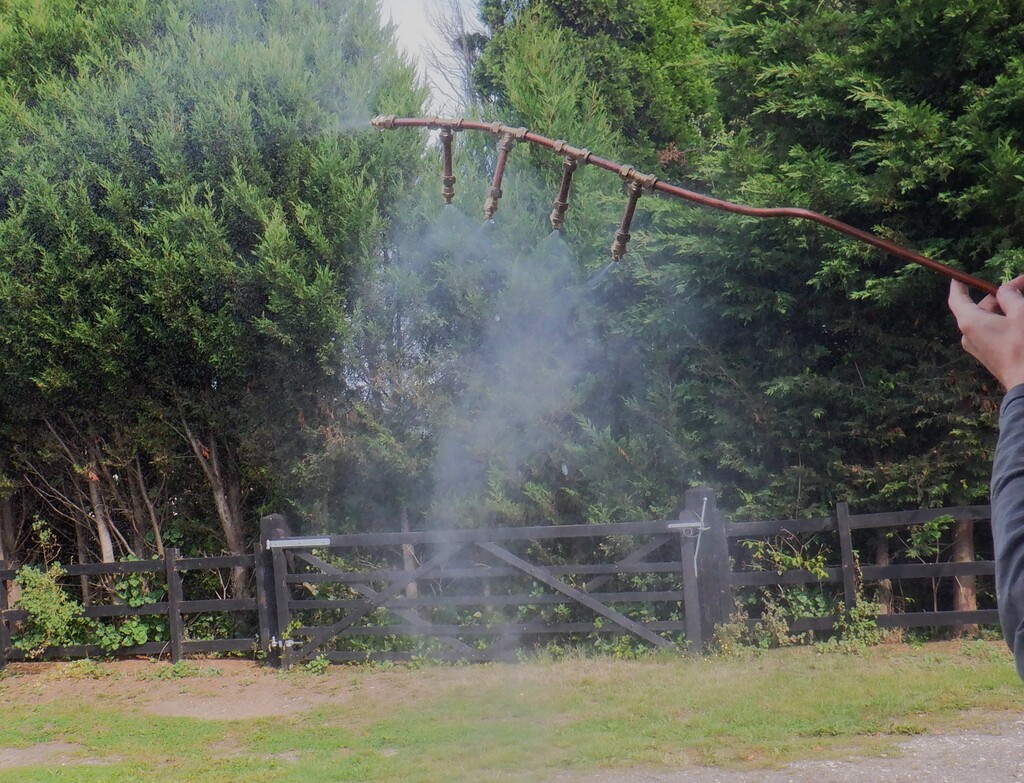We have been researching into what we would need to incorporate a fire suppression system, using spray nozzles to produce a fine mist of water droplets. We have found that if we use micro-bore 10mm water pipes, we can lay in a network of a water pipe running around inside the roof rafters, and now and again, have a “T” junction to a spray nozzle outlet. We have been testing various different sizes of nozzles, connected to a high pressure water pump and seeing what amount of spray is produced.
Our first attempt of a nozzle was to drill a tiny little hole into a brass end-cap, measuring just 0.3mm diameter, we also made two more end-caps with slightly larger holes, 0.4mm and 0.6mm. We tested all three and all three produced a very fine single jet of water going straight out of the nozzle without breaking up into a spray of droplets at all! We realised that there is more to the method of producing a spray so we bought a set of spray nozzles off the web, a bag of 30 nozzles with two sizes, 0.3mm and 0.4mm holes. The only slight problem is that these new nozzles had a American inch threads, labelled “10/24” (which is 0.196″@24 thread per inch). We took our brass end-caps and drilled a 3.7mm hole and then tapped a thread using a 3/16inch (0.187″@24 TPI) tap. It was compatible enough to allow us to screw in our new nozzles. So we tried the 0.3mm hole, producing a very fine misty like cloud which wouldn’t go very far and had a low thermal mass, which may not suppress a fire very well.
We then drilled out their little hole with various sizes, from 0.6mm, 0.9mm, 1.1mm to a 1.5mm holes and each progressively produced heavier droplets in the cloud of spray. We felt that the largest hole was a bit too heavy and the “cloud” was much smaller. It looks as if the 0.6mm hole size was vigorous enough to generate a large cloud and quite a lot of thermal mass, to cool down a fire and reduce the smoke levels.
The test results were all for a single nozzle and the pump was generating pressures of approximately 8bars of pressure (800kilo-pascals)so we knew that we had to make sure that multiple nozzles would work as well, so towards this aim, we made up four more nozzles, each with a 0.6mm hole size and then joined all 5 together and re-run the test and we still generated a huge cloud of spray and the output pressure from the pump only fell down to 6bar.
This means that the method and choice of pipework is ok and gives us a solution and we can order a whole bunch more of these 10mm T junction pieces, along with more inserts for the plastic coil of 10mm pipe we already got.
They will come in a few days time.
This will allow us to install about fifteen nozzles in total for the whole of the Great Room, running around in the lower part of the sloping ceiling and up around the Skylight as well.
Our first attempt of a nozzle was to drill a tiny little hole into a brass end-cap, measuring just 0.3mm diameter, we also made two more end-caps with slightly larger holes, 0.4mm and 0.6mm. We tested all three and all three produced a very fine single jet of water going straight out of the nozzle without breaking up into a spray of droplets at all! We realised that there is more to the method of producing a spray so we bought a set of spray nozzles off the web, a bag of 30 nozzles with two sizes, 0.3mm and 0.4mm holes. The only slight problem is that these new nozzles had a American inch threads, labelled “10/24” (which is 0.196″@24 thread per inch). We took our brass end-caps and drilled a 3.7mm hole and then tapped a thread using a 3/16inch (0.187″@24 TPI) tap. It was compatible enough to allow us to screw in our new nozzles. So we tried the 0.3mm hole, producing a very fine misty like cloud which wouldn’t go very far and had a low thermal mass, which may not suppress a fire very well.
We then drilled out their little hole with various sizes, from 0.6mm, 0.9mm, 1.1mm to a 1.5mm holes and each progressively produced heavier droplets in the cloud of spray. We felt that the largest hole was a bit too heavy and the “cloud” was much smaller. It looks as if the 0.6mm hole size was vigorous enough to generate a large cloud and quite a lot of thermal mass, to cool down a fire and reduce the smoke levels.
The test results were all for a single nozzle and the pump was generating pressures of approximately 8bars of pressure (800kilo-pascals)so we knew that we had to make sure that multiple nozzles would work as well, so towards this aim, we made up four more nozzles, each with a 0.6mm hole size and then joined all 5 together and re-run the test and we still generated a huge cloud of spray and the output pressure from the pump only fell down to 6bar.
This means that the method and choice of pipework is ok and gives us a solution and we can order a whole bunch more of these 10mm T junction pieces, along with more inserts for the plastic coil of 10mm pipe we already got.
They will come in a few days time.
This will allow us to install about fifteen nozzles in total for the whole of the Great Room, running around in the lower part of the sloping ceiling and up around the Skylight as well.
